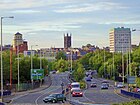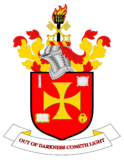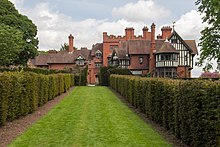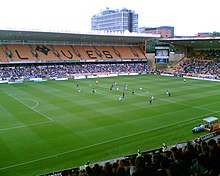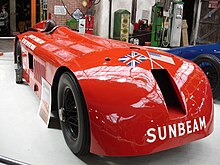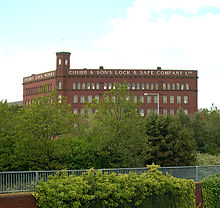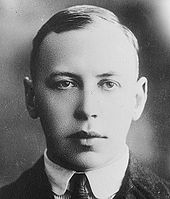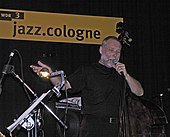Wolverhampton
| Wolverhampton | |||
|---|---|---|---|
|
|||
| Coordinates | 52 ° 35 ′ N , 2 ° 8 ′ W | ||
|
|
|||
| Residents | 262,008 (as of June 30, 2018) | ||
| surface | 69.44 km² (26.81 mi² ) | ||
| Population density: | 3773 inhabitants per km² | ||
| administration | |||
| prefix | 01902 | ||
| Part of the country | England | ||
| Shire county | West Midlands | ||
| Ceremonial county | West Midlands | ||
| ONS code | 00CW | ||
| Website: www.wolverhampton.gov.uk | |||
Wolverhampton is a city in the United Kingdom of Great Britain and Northern Ireland and at the same time a Metropolitan Borough with the status of a City in the English Metropolitan County of West Midlands within the region of the same name . In 2012 the total city area had 252,987 inhabitants, making the city the thirteenth largest in England.
geography
Geographical location
Wolverhampton is the second largest city in the West Midlands conurbation and is located just 20 km northwest of the megacity Birmingham . North and west of Wolverhampton are the landscapes of Staffordshire and Shropshire .
The settlement area between Birmingham and the city center of Wolverhampton is known as the Black Country due to its historical influence from coal mining . Of Wolverhampton, however, only the southeastern parts of the Metropolitan Borough such as Bilston and Heath Town are usually included. However, there is no uniform delimitation.
The city is located on the so-called Midlands Plateau at about 120 m ASL . Several rivers have their source in the Wolverhampton metropolitan area: the River Penk and the River Tame are tributaries of the River Trent , and the Smestow Brook is a tributary of the Stour , which in turn flows into the Severn . Since the River Trent flows into the North Sea via the Humber and the Severn into the open Atlantic , Wolverhampton is located exactly on the main watershed of Great Britain.
geology
The geology of the area is very complex. There is a combination of rock layers from the Triassic and Carboniferous ages . In particular, these are red sandstone , Keuper and coal seams . In addition, there are even dolerite rocks of volcanic origin.
history
Early history
Legend has it that the Anglo-Saxon King Wulfhere founded a monastery dedicated to Saint Mary on the site of today's Wolverhampton in 659 . So far, however, no solid evidence has been found for this.
Wolverhampton is considered to be the site of the Battle of Tettenhall , a major conflict between the Anglo-Saxons and the Danes in 910. However, it is unclear whether the battle took place at Wednesfield or at Tettenhall (both now part of Wolverhampton). The Anglo-Saxons won a decisive victory over the Vikings.
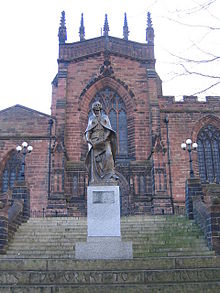
In 985, the Anglo-Saxon King Æthelred transferred land to the wealthy landowner Wulfrun in a place that was officially designated as Heantun . She founded a monastery in Wolverhampton in 994 , to which she transferred further lands. St. Peter's Collegiate Church stands on the site of the monastery today . A statue was erected in honor of Wulfrun on the forecourt of the church.
A market in Wolverhampton is first mentioned in 1179. Market rights for a Wednesday market were only given to the city in 1258 by King Heinrich III. allocated. In the 14th and 15th centuries an important role of the city in the early textile trade could be demonstrated, which is still reminiscent of the city's coat of arms, which contains a bundle of cloth.
In 1512, the former Lord Mayor of London Stephen Jenyns founded Wolverhampton Grammar School , one of the oldest operating schools in Great Britain today.
In April 1590 and September 1696 there were big city fires. The first fire, which lasted five days, left about 700 people homeless. The second fire destroyed 60 houses and lasted five hours. In 1703 a fire fighting vehicle was procured for fire fighting.
In 1606, farm owners Thomas Smart and John Holyhead were hung, gutted and quartered for hosting some of the Gunpowder plot conspirators who had previously fled to the West Midlands. Days later, Guy Fawkes' own conspirators were also executed.
19th century

During the Victorian Age, the city prospered due to its thriving industry, which was favored by the existence of raw materials such as coal and iron. Many of the buildings built during this period have been replaced by new ones from the 1960s and 1970s.
In the 19th century, bad harvests resulted in major immigration from Ireland and Wales .
For the first time the city was represented in parliament as part of the Reform Act 1832 . At the time, Wolverhampton was one of 22 cities that each had two Members of Parliament . According to the Municipal Corporations Act 1835 , the city was combined into a municipal borough in 1848 , before being elevated to a county borough in 1889 .
In 1866 a statue was erected in honor of Albert von Sachsen-Coburg and Gotha . His cousin and wife Queen Victoria , the grandmother of the German Emperor Wilhelm II , was present at the unveiling . It was the Queen's first public appearance since her husband's death in 1861. She was so delighted with the statue that she knighted then Mayor John Morris. In memory of this momentous visit, the market square previously known as the High Green was renamed Queen Square . The statue replaced a Russian cannon that was captured in Sevastopol during the Crimean War in 1855 and placed in the same place.
In 1837 the city received its first rail connection. The first station was built in what is now Heath Town by Grand Junction Railway . In 1965 the station was demolished again.
20th century
The building of the train station, built in 1852 at its current location, was demolished in 1965 and replaced by a new building. A second station, operated by the Great Western Railway , was built in 1855. 1972 the passenger traffic and 1981 all traffic at this station was stopped. The station is currently being restored. The first trolleybuses were used in 1923, and in 1930 the city briefly had the largest trolleybus system in the world. The trolleybus traffic was discontinued in 1967.
On Princes Square in 1927, the first automatic traffic lights in England were installed. The masts of today's systems were given the original paint as a reminder.
Wolverhampton's local politics attracted particular attention when the Conservative MP Enoch Powell warned in his “Rivers of Blood” speech against foreign infiltration from the Commonwealth to Great Britain. As a result, Enoch was dismissed from Edward Heath's shadow cabinet in 1968 . In fact, a large number of immigrants settled in various boroughs of Wolverhampton during the 1950s and 1960s. As a result, there were repeated racist unrest in 1981, 1985 and 1989.
As part of an administrative reform, the city was named a Metropolitan Borough in 1974. On December 18, 2000, the British government announced that it would give Wolverhampton the title of City . Previous applications for this title were consistently denied in 1953, 1966, 1977, 1985 and 1992. In 2002 the application for a Lord Mayor was also rejected.
Many of the city's buildings were constructed in the early 20th century or before. The oldest buildings are St Peter's Church from the 13th century. and a 17th-century half-timbered building on Victoria Street . Originally used as a private residence, the building was later converted into an inn. After a complete renovation in 1981, the building served various purposes; it currently houses a second-hand shop.
In the 1960s, plans arose to build a ring road that would enclose the city center. By the end of the decade, more than half of the ring was completed. The ring closure did not take place until 1986.
In the 1960s a police station was built in the southern city center, but its functions were reduced with the construction of a new station in the early 1990s. The new station was opened on July 31, 1992 by Princess Diana .
As part of the celebrations at the turn of the millennium, Queen Elizabeth II awarded the city the status of a city in 2000 .
Population development
The following tables show the population development of Wolverhampton. The first table covers the historically grown Wolverhampton, the second table covers the area currently administered by Wolverhampton City Council .

| Historic Wolverhampton Population Statistics | |||||||||||
| year | 1750 | 1801 | 1811 | 1821 | 1831 | 1841 | 1851 | 1861 | 1871 | 1881 | 1891 |
|---|---|---|---|---|---|---|---|---|---|---|---|
| Residents | 7,454 | 20,710 | 29,253 | 35,816 | 46,937 | 68,426 | 90,301 | 111.033 | 68.291 | 75,766 | 82,662 |
| year | 1901 | 1911 | 1921 | 1931 | 1939 | 1951 | 1961 | 1971 | 1981 | 1991 | 2001 |
| Residents | 94.107 | 95,328 | 102,342 | 133,212 | 143.213 | 162.172 | 150,825 | 269.168 | 265,631 | 257.943 | 251,462 |
| Issac Taylor's Map 1750 • Township 1801–1881 • Urban Sanitary District 1891 • County Borough 1901–1971 • Urban Subdivision 1981–2001 | |||||||||||
| Population development of the current from Wolverhampton City Council managed area | |||||||||||
| year | 1750 | 1801 | 1811 | 1821 | 1831 | 1841 | 1851 | 1861 | 1871 | 1881 | 1891 |
|---|---|---|---|---|---|---|---|---|---|---|---|
| Residents | k. A. | 11,786 | 15,597 | 19,012 | 23,067 | 54,365 | 70.112 | 87,254 | 104,395 | 121,537 | 130,868 |
| year | 1901 | 1911 | 1921 | 1931 | 1939 | 1951 | 1961 | 1971 | 1981 | 1991 | 2001 |
| Residents | 145,645 | 162,098 | 178,068 | 195,621 | 214.359 | 234,893 | 251,435 | 269.166 | 252,474 | 248.454 | 236.573 |
| Source: Vision of Britain | |||||||||||
Religions
| Religions in Wolverhampton | ||||
|---|---|---|---|---|
| 2001 census | Wolverhampton (urban area) | Wolverhampton (Borough) | West Midlands | England |
| Total population | 251,462 | 236,582 | 2,284,093 | 49.138.831 |
| Christianity | 67.4% | 66.5% | 67.0% | 71.7% |
| Sikhism | 7.2% | 7.6% | 3.4% | 0.6% |
| Hinduism | 3.7% | 3.9% | 1.8% | 1.1% |
| Islam | 1.6% | 1.7% | 7.9% | 3.0% |
| no religion | 11.3% | 11.3% | 11.5% | 14.8% |
| no information | 8.2% | 8.4% | 7.8% | 7.7% |
| Source: Office for National Statistics | ||||
politics
coat of arms
On December 31, 1898, the city coat of arms was approved on the occasion of the 50th anniversary of the founding of the City Council . Another coat of arms had been in use since 1848, but it was never officially certified.
The various symbols in the coat of arms represent the history of Wolverhampton. The book symbolizes the educational history of the city, the ball of wool symbolizes the medieval wool trade, the column replicates the column displayed in the churchyard of St. Peter's Collegiate Church , and the keys symbolize the church itself. The padlock symbolizes one of the important industries in the late 19th century: the manufacture of locks. The coal furnace illustrates the importance of the steel industry in the region. The cross is attributed to the Anglo-Saxon King Edgar .
The motto on the coat of arms is: 'Out of Darkness Cometh Light'.
Town twinning
Wolverhampton is twinned with
-
 Buffalo , United States
Buffalo , United States
-
 Jacksonville , United States
Jacksonville , United States
-
 Jalandhar , India
Jalandhar , India
-
 Klagenfurt , Austria
Klagenfurt , Austria
-
 Subotica , Serbia
Subotica , Serbia
-
 Venice , Italy
Venice , Italy
Culture and sights
Theaters and museums
Opened on December 10, 1894, the Grand Theater is Wolverhampton's largest theater. It was designed by architect Charles J. Phipps and built within six months. Henry Irving , Charles Chaplin and Sean Connery performed there . It was also used for appearances by politicians such as Winston Churchill and David Lloyd George . The theater was closed between 1980 and 1982.
The Arena Theater is part of Wolverhampton University and is the venue for numerous performances, both amateur and professional.
The Wolverhampton Art Gallery is home to Britain's largest collection of Pop Art outside the Tate Gallery . In Bantock House within the same park exhibitions are organized contemporary art regularly.
music
The music group Slade , Sahotas , Cornershop , The Mighty Lemon Drops and Babylon Zoo come from Wolverhampton, just as the Soul - and R & B singer Beverley Knight and the drum-and-bass guru Goldie and the Roots Reggae Artists Macka B . The pop - and Contemporary R & B singer Jamelia lives with her family in Wolverhampton. One Direction singer Liam Payne was also born in Wolverhampton.
Several facilities are suitable for large events. In 2003, for example, a Bon Jovi concert took place at the Molineux Stadium . The largest covered venue is Wolverhampton Civic Hall with a capacity of 3,000 spectators. Another hall is the Wulfrun Hall , which can hold a good 1,100 people. There are also a number of smaller venues for musical performances. This includes the 18th century St John's-in-the-Square Church , which is popular for hosting classical concerts.
The two main choirs in the city are the City of Wolverhampton Choir and the Choir of St. Peter's Collegiate Church .
Buildings
The St. Peter's Collegiate Church stands at the highest point of the city center. A large part of the Grade I listed building dates back to the 15th century and is of great architectural and historical interest. The origin of the church goes back to the year 1205.
St. John's Church, opened in 1760, is located on the south side of the city center and is listed as a Grade I listed building .
The Wightwick Manor is a stand-west of the city Victorian mansion , which is one of the few existing buildings today that the influence of the arts and crafts movement were built. The house was owned by a successful 19th century industrial family. The building , which is listed as a Grade I listed building , was built in two stages by 1887 and 1893.
The Molineux Hotel is a former villa that was previously used as a hotel and now houses the city's historical archive. The building in the city center is listed as a Grade II * listed building . It was built around 1720 and expanded several times in the 18th and 19th centuries. In 1860 the area around the building was opened to the public and transformed into the first public city park. Years later, the site was leased to Wolverhampton Wanderers football club . In 1889 the Molineux Stadium was built on it.
The statue of Albert von Sachsen-Coburg and Gotha, erected in 1866, stands on Queen Square . This landmark of the city, visible from afar, is popularly known as "The Man on the Horse" .
Parks
Public parks in Wolverhampton include East Park, West Park, Bantock Park, Wrightwick Family Park, Valley Park, Fallings Park and Heath Town Park.
Sports
Soccer
Wolverhampton is represented in English football by the Wolverhampton Wanderers . The club, which now plays in the Premier League , was one of the founding members of the Football League , the top division at the time , in 1888 . The club achieved its greatest successes in the 1950s when it won three national championships and two FA Cup titles. The Wanderers were among the first teams to take part in international games and were the first English team to ever play in the Soviet Union . In 1967 the Wolves also won the only title in the North American United Soccer Association as Los Angeles Wolves .
In total, the club won three national championships, four FA Cup titles and two League Cup titles. In 1972 the final of the UEFA Cup was also reached. Between 1984 and 2009, however, the club only spent one season in the top English division, otherwise he had to compete in the English professional leagues two to four. After three seasons in the first division, the Wolverhampton Wanderers had to relegate back to the second division in 2012. The Wolves are the only club that has won the championship in all four leagues. The home ground of the Wolves has been the Molineux Stadium since 1889 with a capacity of 28,525 spectators.
The Wolves' most famous players include Billy Wright , Bert Williams , Johnny Hancocks , Dicky Dorsett , John Richards , Geoff Palmer , Emlyn Hughes , Wayne Clarke , Steve Bull and the homegrown Robbie Keane , Joleon Lescott and Wayne Hennessey . The team's best-known coaches included Stan Cullis (who previously appeared as a player), Bill McGarry , John Barnwell , Tommy Docherty , Graham Turner , Graham Taylor , Dave Jones , Glenn Hoddle and Mick McCarthy . Taylor and Hoddle also coached the English national football team and McCarthy coached the Irish national team before joining the Wolves.
The city also has an amateur club, Wolverhampton Casuals , which plays in the 10th class West Midlands (Regional) League Premier Division .
athletics
The Wolverhampton & Bilston Athletics Club is located in the Aldersley Leisure Village . It was created in 1967 through the merger of the Wolverhampton Harriers with the Bilston Town Athletic Club . The club won the National League Division One from 1975 to 1982 and the cup finals in 1976, 1977, 1979 and 1980. It also represented Great Britain from 1976 to 1983 in the European Clubs Cup. Medalists from Wolverhampton are Denise Lewis , Tessa Sanderson , Kathy Smallwood-Cook , Garry Cook and Sonia Lannaman .
Motorsport
The winner of the 1970 edition of the 24 Hours of Le Mans Richard Attwood comes from Wolverhampton.
Wolverhampton-based vehicle manufacturer Sunbeam built numerous racing cars in early motorsport, including the only British make to win a Grand Prix in the first half of the 20th century . Sunbeam also built various vehicles that have now set a new land speed record. Below is the Sunbeam 1000hp pictured on the right , which overcame the 200 mph limit (322 km / h ) in 1927 .
Car manufacturer Kieft Cars , also based in Wolverhampton, built racing cars for Formula 3 in the early 1950s . Their best driver was Stirling Moss , who later became successful in Formula 1 .
The motorcycle manufacturer AJS , founded in Wolverhampton, took part in numerous motorcycle racing competitions before and after the Second World War. In 1949 it was even possible to win both the driver's and the manufacturer's championship in the 500 cc class of the motorcycle world championship with driver Leslie Graham .
In speedway sports, the city is represented by the Wolverhampton Wolves , who compete in the Speedway Elite League . Your home race course is the Monmore Green Stadium , which is one of the oldest (since 1928) operating racetracks in the world. Famous Wolves racing drivers included Ole Olsen ( individual world champion 1971 and 1975) Sam Ermolenko (world champion 1993) and Tai Wofhaben (world champion 2013).
Equestrian sport
Wolverhampton Racecourse is north of the city center. It is the only floodlit racetrack in Great Britain. Greyhound races are also held at Monmore Green .
Cycling
The Wolverhampton Wheelers were founded in 1891 and are the city's oldest cycling club. It was the hometown club of Hugh Porter , who won four medals at cycling world championships, and Percy Stallard , who brought cycling to Great Britain with the 1942 race from Llangollen to Wolverhampton. The club also regularly uses the Velodrome at Aldersley Stadium.
Wolverhampton has also hosted the Tour of Britain several times : in 2006 the city was a stage start location, in 2007 a stage destination and in 2008 the destination of a sprint stage.
darts
The Professional Darts Corporation (PDC) has been holding the Grand Slam of Darts in Wolverhampton's Civic Hall since 2006 . The special thing about the tournament is the joint participation of major winners from both world associations PDC and BDO (British Darts Organization).
Economy and Infrastructure

Wolverhampton has traditionally been shaped by engineering and manufacturing industries. The service sector , however, has grown steadily and in 2008 achieved an employment share of 74.9%. This includes public administration, education and the health sector (32.8%) as well as sales, the hotel and catering industry (21.1%) and the finance and IT sector (12.7%). The manufacturing industry has the largest share of employment outside the service sector with 12.9%. A total of 5.2% of all employees work in the tourism industry.
The Wolverhampton City Council , with over 12,000 employees the largest employer.
Wolverhampton was the fourth largest retail center in the West Midlands region in 2006 . That year it had a turnover of £ 384 million. By 2015, the city should rise to rank 2.
Companies based in Wolverhampton are or were, among others, the vehicle manufacturers AJS , Clyno , Guy Motors , Kieft Cars , Norton Motorcycles , Sunbeam Car Company , Sunbeam Motorcycles , the aircraft manufacturer Boulton Paul Aircraft and the tire manufacturer Goodyear Tire & Rubber Company .
Goodyear founded a tire factory in the Fordhouses district in 1927. In 2003, however, it was decided to close the company the following year, which meant the loss of 400 jobs. In the period after 1997, around 2,000 jobs were gradually cut.
The borough's unemployment rate in November 2007 was 4.7%. The rate was particularly high in the districts of Ettingshall, St Peter's and Heath Town at over 7%. In the Penn, Tettenhall Wightwick and Tettenhall Regis counties it was less than 3%.
traffic
Private transport
Wolverhampton is close to several motorways , all of which go within ten kilometers of the city:
- The M6 connects the city with the metropolitan areas of Manchester and Liverpool and continues to the Scottish border. In the south-east, the M6 meets the M1 at rugby , which connects to London . The Wolverhampton section is one of the busiest routes in the UK.
- The M5 branches off east of the city from the M6 and runs south-west via Bristol to Exeter .
- The M54 branches off the M6 north of town and leads to Telford ; then the route continues as the A5 via Shrewsbury to Bangor in Welsh .
Wolverhampton has a city ring that keeps through traffic away from the actual city center. The following A-roads are part of the ring: the A41 ( London - Birkenhead ), the A449 ( Stafford - Ross-on-Wye ), the A454 ( Bridgnorth - Sutton Coldfield ) and the A4123 to Birmingham . The A4123 was opened in 1927 and is considered the first overland connection in the UK to be built specifically for road traffic.
Rail and bus transport
Wolverhampton Station is on the West Coast Main Line with direct connections to London, Birmingham, Manchester and several other cities on the island. The station is currently under construction until 2012 as part of a project called Wolverhampton Interchange .
In addition to the long-distance connections, there are some lines of regional importance, for example on the Cambrian Line (to Newtown ), on the railway line to Walsall , on the line to Shrewsbury and on the railway line Rugby – Birmingham – Stafford .
The central bus station is right next to the train station, which enables quick transfers between bus and train. As part of the redesign of the station, the bus station will also be completely rebuilt. The renovation also provides for the construction of new residential and shopping opportunities next door; This area should be completed in 2011.
The bus network is operated by the West Midlands Passenger Transport Executive ; National Express West Midlands operates most of the bus routes in town . In addition to numerous inner-city lines, buses also run to nearby Birmingham, Dudley , Walsall , Sedgley , Bilston , Willenhall and Bloxwich .
Midland Metro
The Midland Metro is a regional light rail , opened in 1999 , which consists of a 20.2 km long line and runs from Wolverhampton via West Bromwich and Wednesbury to Birmingham Snow Hill Station . Extensions such as an inner-city tram line and a line to Walsall via Wednesfield and Willenhall are planned.
air traffic
Originally there was an airport near Pendeford , now a part of Wolverhampton, which was in operation from 1938 to 1970. There is currently an airfield 13 km southwest of the city center, but local residents have successfully prevented its commercial expansion. The nearest international airport is Birmingham Airport, 25 miles away , which can be reached directly by train. By car, Manchester Airport (approx. 100 km away) can be reached more quickly due to the often dense traffic on the M6 in the Birmingham area.
Other traffic
There are no navigable rivers in the city, but Wolverhampton is accessible through three canals: the Birmingham Main Line Canal , the Staffordshire-Worcestershire Canal and the Wyrley-Essington Canal . The industrial use of the canals is now only minor, and so they are mainly used for tourism today.
Most places within the borough and some villages in South Staffordshire can be easily reached by bike, with little inclines usually to be climbed. Bicycle traffic in the city center benefits from the 20 mph zone (32 km / h) that was set up within the City-Ring. Wolverhampton is located on Route 81 on the National Cycle Network from Smethwick to Telford .
Healthcare
The New Cross Hospital is the largest hospital in the region with around 700 beds and serves as a teaching hospital for the University of Birmingham . It was originally opened as a poor house in the eastern part of Wednesfield in 1903 and has been run by the Royal Wolverhampton NHS Trust since 1994 .
media
Wolverhampton is home to the daily Express & Star , which claims to have the largest catchment area for a regional evening paper in the UK.
The four radio stations WCR FM , 107.7 The Wolf , Beacon Radio and Classic Gold WABC are based in the city.
Personalities
sons and daughters of the town
- Jonathan Wild (1683–1725), one of England's most notorious criminals
- Catherine Eddowes (1842–1888), victim of the serial killer Jack the Ripper
- Dickie Baugh (1864-1929), football player
- Thomas John l'Anson Bromwich (1875–1929), mathematician and physicist
- Alfred Noyes (1880–1958), poet
- Ernest Cox (1883–1959), engineer and entrepreneur
- Herbert Westren Turnbull (1885–1961), mathematician
- Maggie Teyte (1888–1976), soprano
- Billy Hartill (1905–1980), football player
- George Bullock (1916–1943), football player
- Bob Thom (1917-2004), racing cyclist
- Jack Hayward (1923-2015), businessman
- John Rhodes (* 1927), racing car driver
- John Taylor (1930-2012), football referee
- Don Howe (1935-2015), football player and coach
- Bill Asprey (born 1936), soccer player and coach
- Alan Barrett (1938–1991), costume designer
- Rachael Heyhoe Flint, Baroness Heyhoe Flint (1939-2017), cricketer
- Richard Attwood (* 1940), racing car driver
- Hugh Porter (born 1940), racing cyclist
- Tony Pitt (* 1940), jazz musician
- Vic Pitt (born 1941), jazz musician
- Margaret Lee (born 1943), actress
- Paul Willis (* 1945), cultural sociologist and folklorist
- Dave Holland (* 1946), jazz bassist and composer
- Michael Dibdin (1947–2007), crime novelist and writer
- John Cooper (* 1948), racing car driver
- Dave Holland (1948-2018), drummer
- Nigel Bennett (born 1949), British-Canadian actor
- Helene Hayman, Baroness Hayman (* 1949), politician
- Jim Lea (musician) (* 1949), bass player for the band Slade
- Kevin Rowland (born 1953), singer, composer and band leader
- Narinder Dhami (* 1958), children's and youth author
- Nigel Slater (* 1958), journalist, cook and author
- Paul Raven (1961-2007), bassist
- Richard Nerurkar (* 1964), long-distance runner
- Goldie (* 1965), DJ and producer
- Bill Etheridge (* 1970), politician
- Karl Keska (* 1972), long-distance runner
- Karl Henry (* 1982), football player
- Leon Clarke (born 1985), football player
- Keith Lowe (born 1985), football player
- Richard Stearman (born 1987), football player
- Andrew Tennant (* 1987), cyclist
- Mark Davies (* 1988), soccer player
- Ashley Hemmings (born 1991), soccer player
- Liam Payne (* 1993), singer in the boy band One Direction
- Matthew Hudson-Smith (born 1994), track and field athlete
- Anya Chalotra (* 1995 or 1996), actress
Personalities who have worked on site
Politicians working in Wolverhampton were and are, among others, Enoch Powell , Sir Charles Pelham Villiers and Helene Hayman, Baroness Hayman , the first spokeswoman for the British House of Lords .
Well-known athletes living in the city were and are, among others, the football players Billy Wright , Steve Bull , Bert Williams and Jimmy Mullen , the cyclist Percy Stallard and Hugh Porter , the swimmer Anita Lonsbrough , the dart player Wayne Jones , the racing car driver and 24 hours of Le Mans winner Richard Attwood , track and field athletes Tessa Sanderson and Denise Lewis and cricketer Vikram Solanki , who grew up here and played for his hometown club Wolverhampton Cricket Club.
The sculptor, painter and medalist Robert Jackson Emerson (1878-1944) worked in Wolverhampton from 1910.
The actors Nigel Bennett , Goldie , Frances Barber , Meera Syal and Eric Idle as well as the musicians Noddy Holder , Dave Hill , Jamelia , Beverley Knight , Dave Holland , Maggie Teyte , Edward Elgar , Mitch Harris and Robert Plant come from Wolverhampton .
Web links
- The City website (English)
Individual evidence
- ^ A b Mid 2018 Estimates of the population for the UK, England and Wales, Scotland and Northern Ireland
- ↑ Key Statistics for Urban Areas in the Midlands (PDF) Office for National Statistics. Archived from the original on July 24, 2004. Retrieved July 2, 2008.
- ^ House of Commons Hansard Debates for 23 Apr 2007 . United Kingdom Parliament. Archived from the original on February 15, 2012. Retrieved June 17, 2008.
- ^ The West Midland Group: Conurbation: A Survey of Birmingham and the Black Country . The Architectural Press, London 1948, p. 41.
- ^ Anglicanism in Wolverhampton . Wolverhampton Archives and Local Studies. Retrieved June 13, 2008.
- ^ The Battle of Tettenhall, Wednesfield, wherever . Wolverhampton History & Heritage Society. Retrieved on June 13, 2008. ( Page no longer available , search in web archives )
- ↑ Wolverhampton City Council - Wodensfield School . Wolverhampton City Council. Archived from the original on September 1, 2007. Retrieved July 8, 2007.
- ↑ Wodensfield Tower . Skyscraper Page. Retrieved July 8, 2007.
- ↑ a b c d e f History of Wolverhampton . Wolverhampton History and Heritage Society. Retrieved June 13, 2008.
- ^ Wolverhampton Grammar School . Wolverhampton Grammar School. Archived from the original on June 18, 2008. Retrieved June 16, 2008.
- ↑ A History of Wolverhampton 985-1985 . John Woodfield. Archived from the original on August 28, 2007. Retrieved June 26, 2008.
- ^ Queen Victoria's Visit to Wolverhampton . Wolverhampton Archives & Local Studies. Archived from the original on February 14, 2008. Retrieved June 17, 2008.
- ^ The first trunk line - The Grand Junction Railway (PDF) Virgin Trains. Archived from the original on October 3, 2008. Retrieved July 1, 2008.
- ^ Heath Town Station . Wolverhampton History and Heritage Society. Archived from the original on October 8, 2006. Retrieved July 1, 2008.
- ↑ Wolverhampton Station . Rail around Birmingham and the West Midlands. Retrieved July 1, 2008.
- ^ Wolverhampton low level . Disused stations. Retrieved July 1, 2008.
- ↑ Graham Sidwell: Wolverhampton Trolleybuses 1961-1967 . Middleton Press, 2006, ISBN 978-1-904474-85-2 .
- ↑ Traffic Control and Traffic Signals . Wolverhampton City Council. Archived from the original on March 8, 2005. Retrieved July 1, 2008.
- ↑ 1985: Riots erupts in Toxteth and Peckham
- ^ City winners named . BBC News. December 18, 2000. Retrieved July 8, 2007.
- ↑ a b c J.V. Beckett: City Status in the British Isles, 1830-2002 . Ashgate Publishing, 2006, ISBN 978-0-7546-5067-6 .
- ↑ The town determined to join the city life . In: The Times , Jan 23, 1985, p. 12.
- ↑ Wolverhampton's Listed Buildings - St. Peter's Collegiate Church ( Memento of September 27, 2012 in the Internet Archive )
- ^ Lindy Lou, AKA The Copper Kettle, 19 Victoria Street, Wolverhampton, 1979.
- ^ Market Street, Wolverhampton June 1981.
- ^ "Wolverhampton, the Millennium City - 10 years on" BBC - Black Country: Accessed March 13, 2010
- ↑ Wolverhampton USD . Vision of Britain. Retrieved July 24, 2008.
- ↑ Wolverhampton USD . Vision of Britain. Retrieved July 24, 2008.
- ^ Wolverhampton County Borough . Vision of Britain. Retrieved July 24, 2008.
- ^ West Midlands Urban Area 1991 Census . National Statistics. Retrieved July 24, 2008.
- ↑ KS01 Usual resident population: Census 2001, Key Statistics for urban areas . National Statistics. Archived from the original on March 6, 2006. Retrieved July 24, 2008.
- ^ Wolverhampton Metropolitan Borough . Vision of Britain. Retrieved July 24, 2008.
- ↑ a b c d e f g Wolverhampton Coat of Arms - Wolverhampton History . Wolverhampton City Council. Retrieved June 11, 2008.
- ↑ Wolverhampton Grand Theater History ( Memento December 7, 2008 in the Internet Archive )
- ^ About the Arena Theater . University of Wolverhampton. Retrieved December 15, 2008.
- ^ Exhibitions at Wolverhampton Art Gallery . Wolverhampton Arts and Museums Service. Retrieved on November 3, 2007. ( Page no longer available , search in web archives )
- ^ Bantock House and Museum . Wolverhampton Arts and Museums Service. Retrieved July 24, 2008.
- ^ Bilston Craft Gallery . Wolverhampton Arts and Museums Service. Retrieved July 24, 2008.
- ^ BBC Black Country music . BBC. Retrieved November 3, 2007.
- ↑ Wolves Civic details . Wolverhampton City Council. Retrieved July 24, 2008.
- ↑ Wolverhampton Wulfrun Hall information . Safe Concerts. Retrieved July 24, 2008.
- ↑ City of Wolverhampton Choir . Retrieved September 23, 2008.
- ^ The Collegiate Church of St Peter in Wolverhampton (pdf; 166 kB) Parish of Central Wolverhampton. Archived from the original on November 20, 2008. Retrieved October 12, 2008.
- ↑ St. John's in the Square . Wolverhampton History and Heritage Society. Archived from the original on October 8, 2006. Retrieved December 10, 2008.
- ^ A b Lydia Greeves: History and Landscape: The Guide to National Trust Properties in England, Wales and Northern Ireland . National Trust Books, 2005, ISBN 1-905400-13-6 , p. 429.
- ^ The Molineux Hotel . Wolverhampton History and Heritage Society. Archived from the original on September 4, 2009. Retrieved January 29, 2009.
- ^ Prince Albert . Wolverhampton History and Heritage Society. Archived from the original on March 17, 2008. Retrieved January 29, 2009.
- ^ Wolverhampton & Bilston Athletics Club . Wolverhampton & Bilston Athletics Club. Retrieved June 18, 2008.
- ↑ Newest Sporting Hall of Fame inductees . Wolverhampton City Council. October 30, 2006. Archived from the original on December 2, 2007. Retrieved June 17, 2008.
- ^ Colin Weyer: Sunbeam - The Supreme Car . The Sunbeam Talbot Darracq Register. Archived from the original on August 7, 2008. Retrieved June 17, 2008.
- ↑ Jim Evans: Cyril Kieft . Wolverhampton History & Heritage Society. Archived from the original on August 28, 2009. Retrieved June 17, 2008.
- ↑ Percy Stallard . In: The History of Wolverhampton - The City and its People . Retrieved June 17, 2008.
- ↑ Grand Slam of Darts 2013 . Retrieved October 23, 2013.
- ↑ Nomis Official Labor Market Statistics 2008 Local Authority Profile: Wolverhampton . Office for National Statistics. Archived from the original on July 17, 2011. Retrieved December 15, 2008.
- ↑ About Us . City of Wolverhampton College. Archived from the original on June 15, 2008. Retrieved June 17, 2008.
- ^ Jobs and Careers . Wolverhampton City Council. Archived from the original on June 3, 2004. Retrieved June 17, 2008.
- ^ West Midlands SSA Regional Summary Spring 2008 ( Memento of September 4, 2009 in the Internet Archive )
- ↑ Wolverhampton City Council Policy Team: Unemployment Briefing (pdf; 356 kB) Wolverhampton City Council. November 2007. Archived from the original on October 3, 2008. Retrieved June 17, 2008.
- ↑ UK'S Congestion Hotspots Revealed . RAC Foundation. Retrieved December 15, 2008.
- ↑ Birmingham New Road circa 1927 . Sedgleymanor Photo Gallery. Retrieved June 17, 2008.
- ↑ A580 East Lancashire Road . Lancashire Roads and Motorways Site. Archived from the original on October 23, 2007. Retrieved July 24, 2008.
- ^ Becky Sharpe: All change at station . In: Express & Star . October 18, 2006. Retrieved June 17, 2008.
- ↑ Plans for £ 174m revamp of Wolverhampton bus station unveiled
- ^ About the Metro . National Express Group. Archived from the original on October 23, 2010. Retrieved October 19, 2010.
- ^ Phil Clayton: The Airport and Boulton Paul . In: The History of Pendeford . Wolverhampton History & Heritage Society. February 2004. Archived from the original on August 19, 2008. Retrieved June 17, 2008.
- ↑ strans Route 81 . Sustrans. Retrieved July 24, 2008.
- ↑ About Us . Express & Star. Retrieved September 9, 2008.
